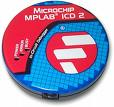Difference between revisions of "Microcontrollers and accessories"
m (→Hardware) |
m (→Hardware) |
||
| Line 4: | Line 4: | ||
== Hardware == | == Hardware == | ||
| − | In AIRLab/Lambrate you can find three Microchip ICD2 "debuggers" (Microchip product number DV164007) | + | In AIRLab/Lambrate you can find three Microchip ICD2 "debuggers" (Microchip product number DV164007). |
[[Image:Microchip_ICD2-DV164007.jpg|center|Microchip ICD2]] | [[Image:Microchip_ICD2-DV164007.jpg|center|Microchip ICD2]] | ||
| + | |||
| + | All these devices should stay in the Lab! If removed, the person taking them have to write that he/she is taking it away on the table at the end of this section. | ||
| + | |||
These are devices which let you write, read and run the code running on a PIC. To do that, the PIC can be accessed in two ways: | These are devices which let you write, read and run the code running on a PIC. To do that, the PIC can be accessed in two ways: | ||
Revision as of 13:13, 11 May 2009
Many AIRLab projects use microcontrollers. There are many producers of microcontrollers, but for legacy reasons we usually tend to use the PIC line of products by Microchip.
Here you can find a good introduction to the design of circuits based on PIC microcontrollers.
Hardware
In AIRLab/Lambrate you can find three Microchip ICD2 "debuggers" (Microchip product number DV164007).
All these devices should stay in the Lab! If removed, the person taking them have to write that he/she is taking it away on the table at the end of this section.
These are devices which let you write, read and run the code running on a PIC. To do that, the PIC can be accessed in two ways:
- if you were thoughtful enough, you designed your PCB including a port to connect to the pins of the PIC used for programming: in this case, the PIC can be left on the PCB and it is sufficient to hook up the ICD2 to the board with a suitable cable;
- if you were not so thoughtful (or if the PCB comes from someone else who wasn't), each time you need to communicate with the PIC you have to extract it from its socket and put it into an auxiliary board (Microchip product number AC162049) connected to the ICD2, then to put it back into the socket when you are finished.
Of course you have to POWER DOWN THE CIRCUIT when taking out the PIC or putting it back!
- - - - - - -
ST REva Evaluation Board STM32 -> Martino Migliavacca (9/4/8)

